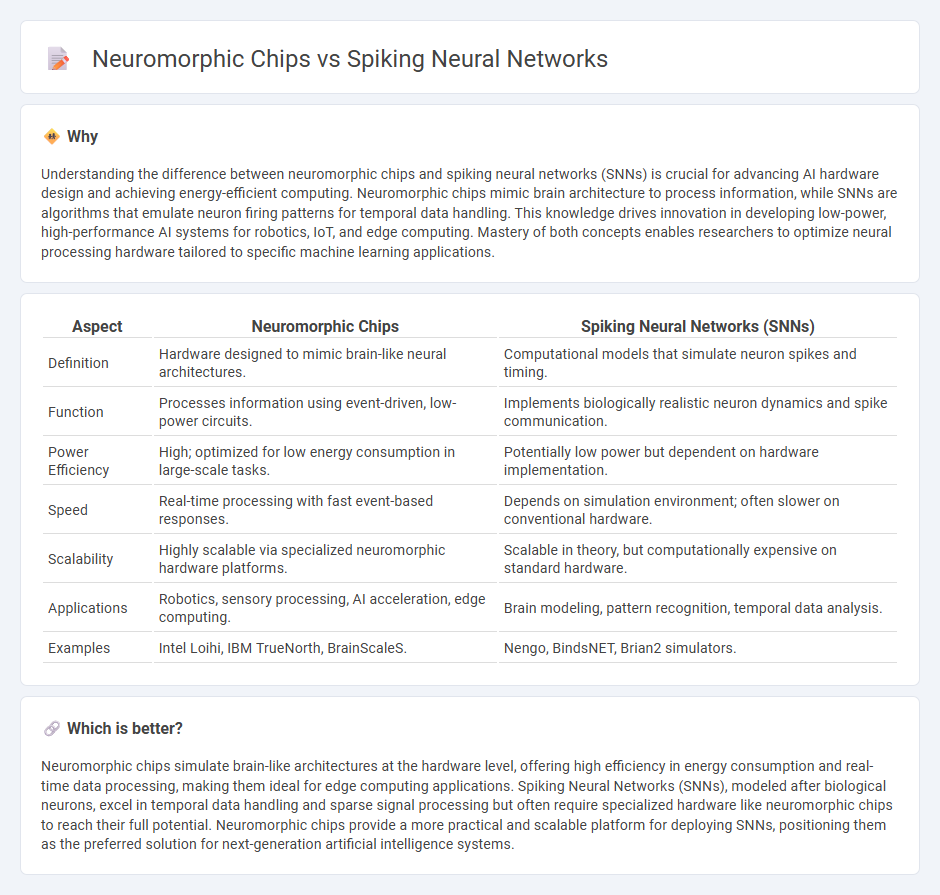
Neuromorphic chips mimic the brain's architecture by using specialized hardware to process information efficiently, while spiking neural networks (SNNs) emulate neuronal activity through discrete spikes for improved temporal data handling. These technologies enhance energy efficiency and computational speed, particularly in AI and robotics applications. Explore further to understand their distinct roles and potential in advancing cognitive computing.
Why it is important
Understanding the difference between neuromorphic chips and spiking neural networks (SNNs) is crucial for advancing AI hardware design and achieving energy-efficient computing. Neuromorphic chips mimic brain architecture to process information, while SNNs are algorithms that emulate neuron firing patterns for temporal data handling. This knowledge drives innovation in developing low-power, high-performance AI systems for robotics, IoT, and edge computing. Mastery of both concepts enables researchers to optimize neural processing hardware tailored to specific machine learning applications.
Comparison Table
| Aspect | Neuromorphic Chips | Spiking Neural Networks (SNNs) |
|---|---|---|
| Definition | Hardware designed to mimic brain-like neural architectures. | Computational models that simulate neuron spikes and timing. |
| Function | Processes information using event-driven, low-power circuits. | Implements biologically realistic neuron dynamics and spike communication. |
| Power Efficiency | High; optimized for low energy consumption in large-scale tasks. | Potentially low power but dependent on hardware implementation. |
| Speed | Real-time processing with fast event-based responses. | Depends on simulation environment; often slower on conventional hardware. |
| Scalability | Highly scalable via specialized neuromorphic hardware platforms. | Scalable in theory, but computationally expensive on standard hardware. |
| Applications | Robotics, sensory processing, AI acceleration, edge computing. | Brain modeling, pattern recognition, temporal data analysis. |
| Examples | Intel Loihi, IBM TrueNorth, BrainScaleS. | Nengo, BindsNET, Brian2 simulators. |
Which is better?
Neuromorphic chips simulate brain-like architectures at the hardware level, offering high efficiency in energy consumption and real-time data processing, making them ideal for edge computing applications. Spiking Neural Networks (SNNs), modeled after biological neurons, excel in temporal data handling and sparse signal processing but often require specialized hardware like neuromorphic chips to reach their full potential. Neuromorphic chips provide a more practical and scalable platform for deploying SNNs, positioning them as the preferred solution for next-generation artificial intelligence systems.
Connection
Neuromorphic chips are designed to mimic the architecture and processing methods of the human brain by utilizing spiking neural networks (SNNs), which communicate through discrete spikes or events rather than continuous signals. These chips leverage SNNs to achieve low-power, high-efficiency computation suitable for tasks like pattern recognition, sensory processing, and autonomous systems. The integration of neuromorphic hardware with spiking neural network algorithms enables advanced real-time AI applications with reduced latency and energy consumption.
Key Terms
Event-driven processing
Spiking neural networks (SNNs) leverage event-driven processing by mimicking biological neurons' spike-based communication, enabling highly efficient data handling only when significant changes occur. Neuromorphic chips implement this approach in hardware, optimizing power consumption and latency by processing sparse, asynchronous events rather than continuous signals. Discover how event-driven processing in SNNs and neuromorphic chips revolutionizes energy-efficient AI applications.
Synaptic plasticity
Spiking neural networks (SNNs) use timed spikes to mimic biological neuron signals, enabling efficient temporal information processing through synaptic plasticity mechanisms such as spike-timing-dependent plasticity (STDP). Neuromorphic chips implement SNN architectures in hardware, facilitating real-time synaptic plasticity with low power consumption and high parallelism, crucial for adaptive learning in edge computing devices. Explore further to understand how these technologies revolutionize adaptive AI and brain-inspired computing.
Low-power computation
Spiking neural networks (SNNs) mimic biological neurons by processing information through discrete spikes, leading to highly efficient, event-driven low-power computation. Neuromorphic chips are hardware implementations designed to optimize SNNs by emulating the brain's parallel architecture, significantly reducing energy consumption compared to traditional processors. Explore how the synergy between SNNs and neuromorphic hardware is paving the way for ultra-low-power AI applications and sustainable computing solutions.
Source and External Links
Deep Learning in Spiking Neural Networks - arXiv - Spiking neural networks (SNNs) are biologically inspired models that process information through discrete spikes, offer temporal dynamics, and have been shown to perform well in pattern recognition tasks using biologically plausible learning rules like STDP.
Spiking neural network - Wikipedia - SNNs are artificial neural networks that more closely mimic the timing-based signaling of real neurons, employ local learning rules, and can be made efficient in energy and computation by incorporating biological features like spike frequency adaptation.
Spiking Neural Networks and Their Applications: A Review - PMC - SNNs bridge neuroscience and AI by modeling the precise timing and sub-threshold dynamics of neuronal spiking, with specialized training algorithms such as SpikeProp and SuperSpike designed to handle the challenges of spike-based learning.
 dowidth.com
dowidth.com